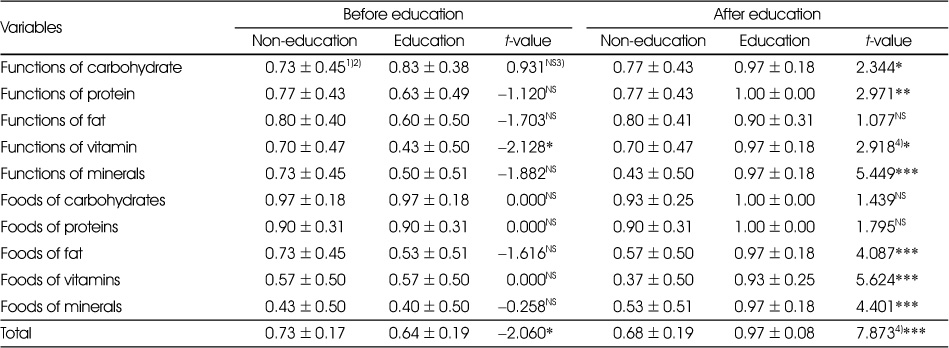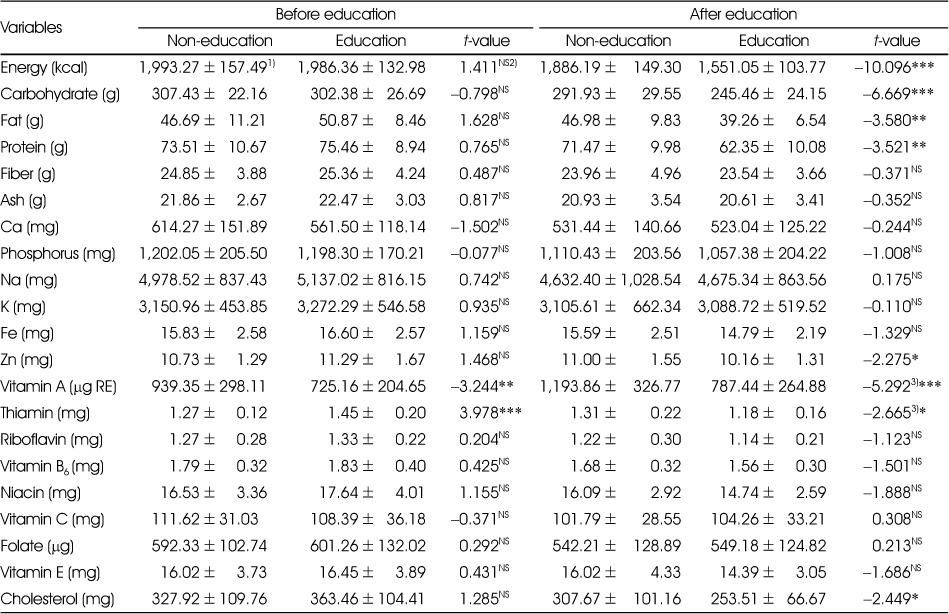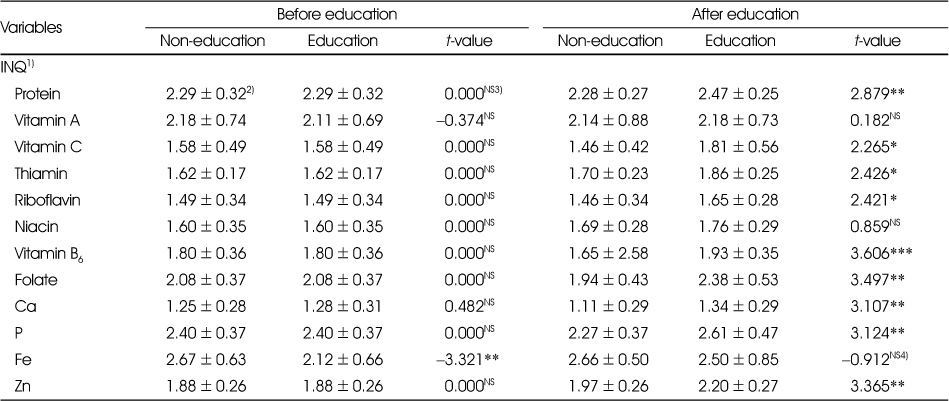Articles
- Page Path
- HOME > Korean J Community Nutr > Volume 22(4); 2017 > Article
-
Research Article
- Effects of Nutrition Education at a Community Health Center on Overweight and Obese Middle-aged Women in Jeonbuk Area-Focused on Personalized Daily Energy Requirement and Food Exchange Units
-
Se-Yeon Kim, Sook-Bae Kim

-
Korean Journal of Community Nutrition 2017;22(4):307-322.
DOI: https://doi.org/10.5720/kjcn.2017.22.4.307
Published online: August 31, 2017
1Department of Nutrition Services, Chonbuk National University Hospital, Jeonju, Korea.
2Department of Food Science & Human Nutrition, Research Institute of Human Ecology, Chonbuk National University, Jeonju, Korea.
- Corresponding author: Sook-Bae Kim. Chonbuk National University, 567, Baekje-daero, Deokjin-gu, Jeonju 54896, Korea. Tel: (063) 270-3823, Fax: (063) 270-3854, sbkim@jbnu.ac.kr
Copyright © 2017 The Korean Society of Community Nutrition
This is an Open-Access article distributed under the terms of the Creative Commons Attribution Non-Commercial License (http://creativecommons.org/licenses/by-nc/3.0/) which permits unrestricted non-commercial use, distribution, and reproduction in any medium, provided the original work is properly cited.
- 813 Views
- 2 Download
- 4 Crossref
Figure & Data
REFERENCES
Citations

- Evaluation of Irisin Levels in Cancer Anorexia Cachexia Syndrome and the Relationship between Nutrition Education and Quality of Life
Diler Us Altay, Duygu Mataracı Değirmenci, Salih Can Çelik, Abdullah Üner, Tevfik Noyan, Çağrı Akalın
Cumhuriyet Science Journal.2024; 45(4): 636. CrossRef - Influence of Comprehensive Lifestyle Intervention (LSI) Program on Health, Fatigue, and Quality of Life in Middle-Aged Women
Su-Jin Jung, Seung-Ok Lee, Min-Jun Choi, Jun Heo, Soo-Wan Chae, Baik-Hwan Cho
Journal of Lifestyle Medicine.2022; 12(3): 127. CrossRef - Effects of Nutrition Education and Exercise Program on Obesity Index and Behavioral Modification in Moderate Obese Women
Myung-Hee Chang, Su-Jin Jung
Korean Journal of Community Nutrition.2018; 23(4): 318. CrossRef - Effects of an Intensive Management Program for Diabetic Patients on a Blood Biochemical Profile and Diabetes Knowledge
Su-Jeong Yeo, Bok-Hee Kim
Korean Journal of Community Nutrition.2018; 23(2): 148. CrossRef
Contents and tools of nutrition education
Effect of nutrition education on anthropometric characteristics
1) Mean ±SD
2) NS: Not Significant
3) BMI: Body Mass Index, BMI = Weight (kg) / [Height (m)]2, < 18.5: underweight, 18.5~22.9: normal, 23.0~24.9: overweight, ≥ 25.0: obese
4) N (%),
5) WHR: Waist/Hip
6) PBF: Percentage of body fat(%)
7) LBM: Lean Body Mass(kg)
8) By ANCOVA test
9) BMR: basal metabolic rate
*: p < 0.05, **: p < 0.01, ***: p < 0.001
Effect of nutrition education on biochemical characteristics
1) N (%)
2) NS: Not Significant
3) Fast blood sugar
4) Impaired Fasting Glucose
*: p < 0.05, ***: p < 0.001
Effect of nutrition education on nutrition knowledge
1) Score: non-corrected, 0; corrected, 1
2) Mean ±SD
3) NS: Not Significant
4) By ANCOVA test
*: p < 0.05, **: p < 0.01, ***: p < 0.001
Effect of nutrition education on dietary attitudes
1) Score: seldom, 1; often, 2; frequent, 3; always, 4
2) Mean ±SD
3) NS: Not Significant
4) (R) denotes a negatively phrased and reversely scored item
**: p < 0.01, ***: p < 0.001
Effect of nutrition education on meals and snacks
1) N (%)
2) NS: Not Significant
3) By ANCOVA test
*: p < 0.05, **: p < 0.01, ***: p < 0.001
Effects of nutrition education on nutrient intake
1) Mean ±SD
2) NS: Not Significant
3) By ANCOVA test
*: p < 0.05, **: p < 0.01, ***: p < 0.001
Effects of nutrition education on INQ
1) INQ: index of nutritional quality
2) Mean ±SD
3) NS: Not Significant
4) By ANCOVA test
*: p < 0.05, **: p < 0.01, ***: p < 0.001
Effects of nutrition education on energy, protein, fiber and vitamins intake
1) N (%)
2) NS: Not Significant
3) EAR: Estimated Average Requirement
4) RNI: Recommended Nutrient Intake
5) AI: Adequate Intake
6) UL: Tolerable Upper Intake Level
*: p < 0.05, **: p < 0.01
Effects of nutrition education on mineral intake
1) N (%)
2) NS: Not Significant
3) EAR: Estimated Average Requirement
4) RNI: Recommended Nutrient Intake
5) UL: Tolerable Upper Intake Level
6) AI: Adequate Intake,
**: p < 0.01
1) Mean ±SD 2) NS: Not Significant 3) BMI: Body Mass Index, BMI = Weight (kg) / [Height (m)]2, < 18.5: underweight, 18.5~22.9: normal, 23.0~24.9: overweight, ≥ 25.0: obese 4) N (%), 5) WHR: Waist/Hip 6) PBF: Percentage of body fat(%) 7) LBM: Lean Body Mass(kg) 8) By ANCOVA test 9) BMR: basal metabolic rate *:
1) N (%) 2) NS: Not Significant 3) Fast blood sugar 4) Impaired Fasting Glucose *:
1) Score: non-corrected, 0; corrected, 1 2) Mean ±SD 3) NS: Not Significant 4) By ANCOVA test *:
1) Score: seldom, 1; often, 2; frequent, 3; always, 4 2) Mean ±SD 3) NS: Not Significant 4) (R) denotes a negatively phrased and reversely scored item **:
1) N (%) 2) NS: Not Significant 3) By ANCOVA test *:
1) Mean ±SD 2) NS: Not Significant 3) By ANCOVA test *:
1) INQ: index of nutritional quality 2) Mean ±SD 3) NS: Not Significant 4) By ANCOVA test *:
1) N (%) 2) NS: Not Significant 3) EAR: Estimated Average Requirement 4) RNI: Recommended Nutrient Intake 5) AI: Adequate Intake 6) UL: Tolerable Upper Intake Level *:
1) N (%) 2) NS: Not Significant 3) EAR: Estimated Average Requirement 4) RNI: Recommended Nutrient Intake 5) UL: Tolerable Upper Intake Level 6) AI: Adequate Intake, **:

 KSCN
KSCN










 PubReader
PubReader Cite
Cite


